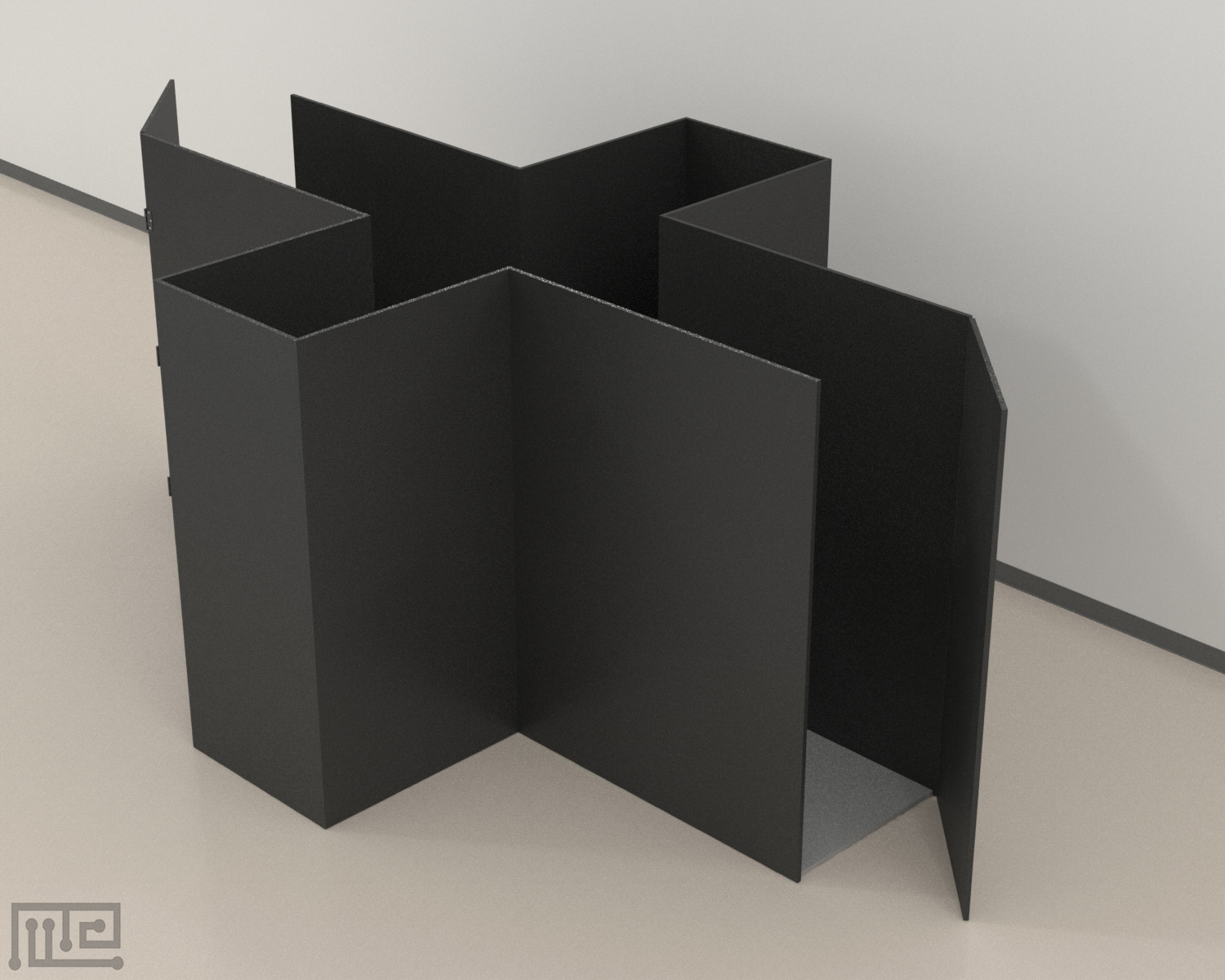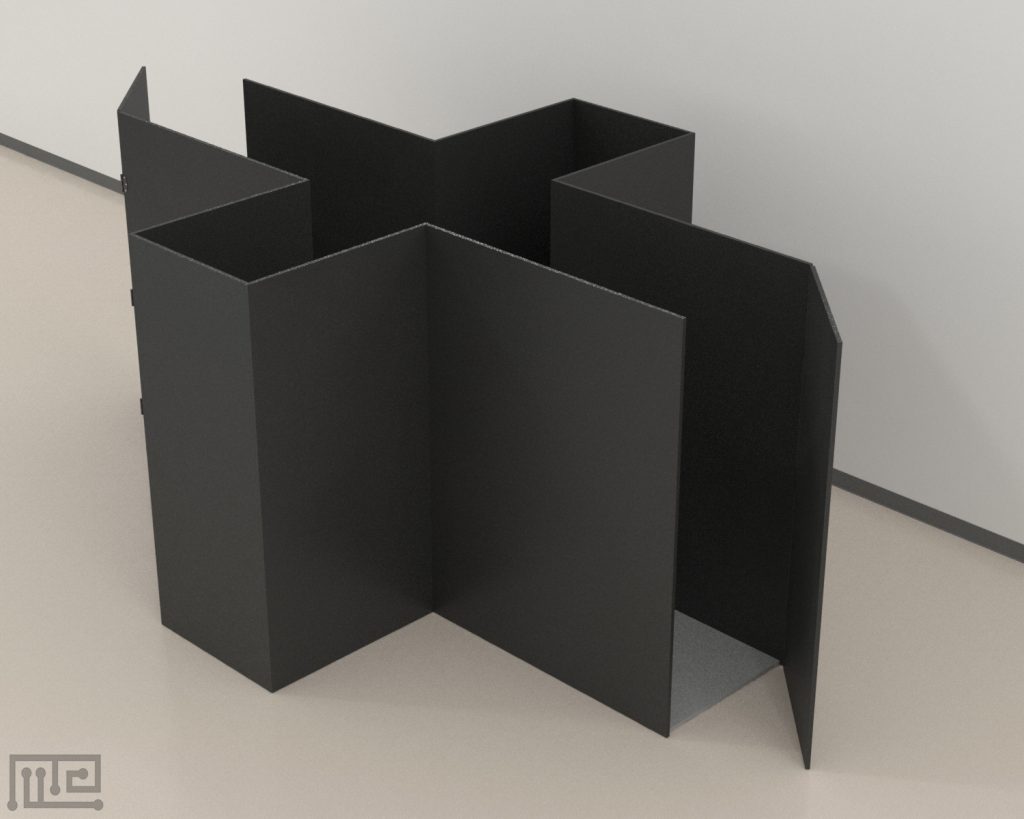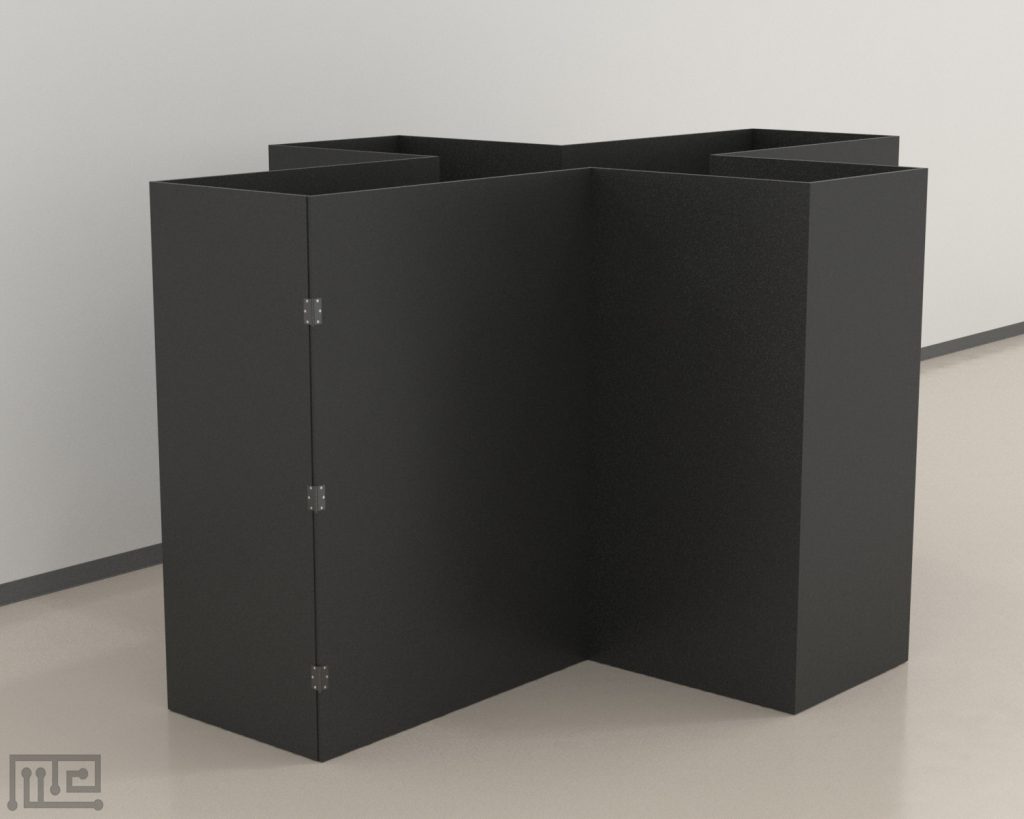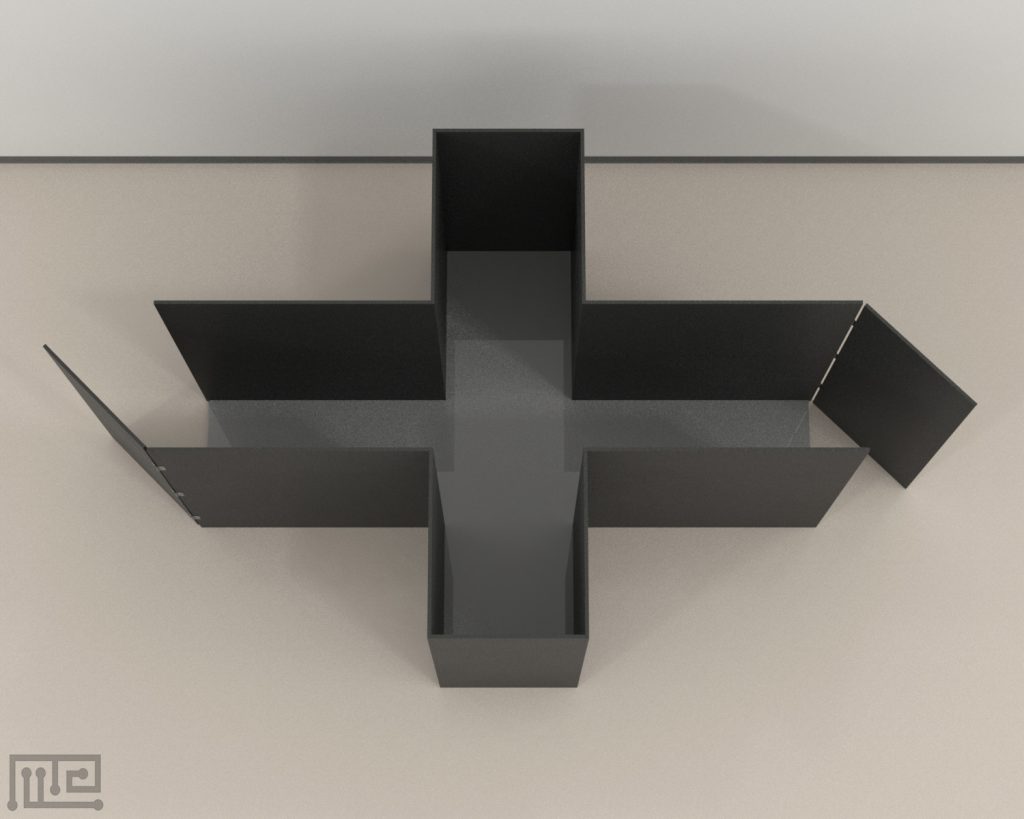Canine Plus Maze is a plus shaped maze made of aluminium panels. It was used by Scandurra et al.(2018), to test the effect of age, sex and gonadectomy on dogs’ use of spatial navigation strategies.
Two of the maze arms (the North arm, N, and the South arm, S) had a door at their end. The two lateral arms (East, E, and West, W), were closed by a fixed panel.
Mazeengineers offer the Canine Plus Maze.
Price & Dimensions
Canine Plus Maze
$ 3990
+S&HHeight of aluminium panels: 2.0mLength of north and south arm: 1.5m
Length of east and west arm: 1.0m
Width of arms: 0.80m
Documentation
Introduction
The Canine Plus Maze is used in the assessment of spatial navigation and cognitive processes of dogs. The maze draws similarities in terms of design to the rodent Elevated Plus Maze (see also Elevated Asymmetric Plus Maze) that is used in the assessment of rodent exploratory behaviors. The maze consists of a central square arena with each side extending into a maze arm. Of the four arms, two opposite arms are short while the other pair has longer arms. Unlike the rodent counterpart that relies on the fear of falling to motivate the subject, the Canine Plus Maze tasks are often performed using positive food rewards. The use of a non-aversive stimulus makes the tasks less stressful for the subject, which in turn reduces the effects of stress on performances.
Cognitive decline is often assessed in animal models of research by their ability to learn and navigate the location of a goal in a maze. The subjects in the Canine Plus Maze are usually trained to find the location of a food reward placed in one of the arms, following which they are evaluated for their ability to recall the correct location. Protocol variations usually involve the presence or absence of spatial navigation cues. Additionally, the maze can also be adapted to include task delays or an element of novelty by the introduction of guillotine doors. Apart from learning and memory-based task, the apparatus can be potentially used with protocols that involve the assessment of preferences.
Other apparatuses used to test spatial navigation in animal models include the Y-Maze, the Hebb Williams, and the Canine Radial Arm Maze.
Apparatus and Equipment
The Canine Plus Maze is a plus-shaped apparatus made up of aluminium panels of 2 m height. The central arena measures 0.80 × 0.80 m and has four 0.80 m wide arms extending from each side. The north (N) and south (S) arms are 1.5 cm long and are equipped with doors at their ends. The east (E) and west (W) arms are 1.0 m long with the ends closed with a fixed panel. The apparatus also comes with two food bowls.
Training Protocol
Ensure that the maze arena is thoroughly cleaned before trials to avoid interference from any additional stimuli on maze performance. Appropriately illuminate the maze arena and take measures to prevent shadows from forming in the maze. For automated tracking and recording of the subject’s behavior and locomotor activity, a video tracking system such as Noldus EthoVision XT can be used.
The following protocol uses a triangle PVC mat that has black and grey stripes from the base to the apex as a spatial cue. Additionally, a pole is also placed on the mat towards the base. The base of the triangle is placed in front of the S arm door.
Habituation and Pre-training
Perform a 10 minutes session of habituation to familiarize the subject with the test area and maze. Walk the subject around the maze to familiarize it with the testing room. After a full round, have the N and S doors opened and walk the subject through the S arm out the N arm door. Repeat the path backward. Ensure that the subjects do not enter the lateral arms (E and W) during this familiarization process. Close the S and N doors once the subject completes the habituation process.
Following the habituation, perform a side choice trial to determine the subject’s side-turning preference. Place empty food bowls in both the E and the W arms of the maze. Open the S door and release the subject to explore the maze arena on its own. As soon as the subject reaches the food bowl in one of the lateral arms, walk the subject out of the maze preventing it from entering the unexplored lateral arm. Use the unvisited lateral arm as the correct choice arm during the learning trials.
Canine Plus Maze Learning Task
Eliminate any visual cues prior to training. Bait the previously unvisited arm in the side choice trial with food rewards. Place the same amount of food under the bowl (not reachable) in the non-baited lateral arm to balance the odor cues. Open the door of the S arm and allow the subject to observe the maze from the entrance for 5 seconds while the handler remains neutral. Release the subject into the maze with the handler staying at the entrance door. Once the subject has entered either lateral arm, allow the handler to enter the maze and walk the subject out, preventing it from visiting the other arm. Perform trials until the subject meets the learning criterion, or 16 trials have been performed.
Preferred Navigational Strategy Assessment Task
In order to eliminate the use of external cues during the task, walk the subject clockwise, and then anticlockwise around the maze. Bait both food bowls in the lateral arms. Repeat the procedure as in the learning trials using the alternate entrance (door in arm N) to the maze. If subjects visit the same arm as in the learning trials, note it as allocentric strategy; however, if the observed behaviors reflect motor response, note it as an egocentric strategy. Repeat the learning task followed by the strategy assessment task to confirm the strategy used by the subject.
Reversal Learning Task
After a 15 minutes interval following navigation strategy assessment, perform the reversal learning task. Perform forced allocentric learning tasks for subjects that relied on egocentric strategy in the navigation strategy assessment and vice versa.
- Forced Allocentric Trial
Place food bowls (baited and un-baited as per the learning task) in the lateral arms and remove the walls of the maze. Keep all spatial cues intact for the trial. Alternate the starting positions between the N and S arms of the maze. Release the animal into the maze and allow it to choose an arm. Once the subject reaches one of the food bowls, immediately remove it from the maze.
- Forced Egocentric Trial
Remove all spatial cues that were used in the learning task. Place the food bowls (baited and un-baited as per the learning task) relative to the position of the entrance door. Alternate the starting positions between the four doors of the maze. Allow the subject to enter the maze from one of the doors and choose an arm. Once the subject reaches one of the food bowls, immediately remove it from the maze.
Perform a maximum of 32 trials until the subject meets the learning criterion. Allocate 10 minutes of resting periods during the session.
Pero et al. (2019) investigated the potential improvements in cognitive abilities of dogs that received DiSeniorTM nutraceutical supplement. A total of 20 different breed dogs (aged between 10 and 17 years) were divided into supplement group (SG; two spayed and one intact female, two neutered and six intact males) and placebo group (PG; three spayed females, two neutered and four intact males). Prior to treatment, baseline performances of the subjects in the Canine Plus Maze was recorded. The treatment plan for both groups lasted 50 days (20 days treatment, 10 days break, and 20 days treatment). On completion of the treatment, subjects were once again evaluated in the Canine Plus Maze. Both treatment groups did not differ significantly in their baseline performances in the maze; however, following the treatment SG group displayed higher percentage correct choices than the PG group during the learning tasks. Performances in the reversal learning task did not reveal any significant differences between the treatment groups.
Assessment of the effect of gonadectomy and sex on spatial strategy preference
Scandurra, Marinelli, Lõoke, D’Aniello, and Mongillo (2018) studied the effect of age and gonadectomy on the preferential spatial strategy of different breed dogs in the Canine Plus Maze. Fifty-six dogs, aged between two and eight years, were divided into four equally sized groups: intact (non-orchiectomized) males, orchiectomized males, intact (non-ovariectomized) females, and ovariectomized females. Of the 56 dogs tested, 43 dogs showed a consistent preference for during navigation strategy assessment trials; 60.7% showed a preference for egocentric strategy while 39.3% were observed to use an allocentric strategy. Though no overall bias towards a strategy could be observed among the groups, ovariectomized females displayed a significant likelihood of using egocentric strategy. Further, in the reversal trials, age-related increase in the probability of success in females and a decrease in male subjects could be observed.
Data Analysis
- Number of trials to reach the learning criterion
- Number of incorrect entries
- Number of correct entries
- Type of navigational strategy
- Time taken to reach the reward
- Time spent in the arm
- Latency to initiate the task
Strengths and Limitations
Strengths
The Canine Plus Maze is a widely used neurobehavioral apparatus to study spatial learning and navigational tasks in dogs. The arms of the maze are wide enough to accommodate subjects of any sizes. The entrance doors enable easy handling of the subjects during the task. The simple design and absence of stressors provide a low-stress environment to the subjects. The use of food rewards increases the motivation of the subject to complete the task. The maze can be easily adapted for different investigations such as by using guillotine doors to introduce task delays and to isolate the subject to a particular arm or to create novel arms.
Limitations
The Canine Plus Maze task relies on food rewards as motivation, and thus, it is important to ensure the subject’s appetitive motivation is consistent throughout trials. Changes in the type of food reward or the quantity of the rewards between trials may demotivate the subject from performing the task. The presence of olfactory, visual, and proximal cues may affect task performance. The results of the task may vary depending upon age, sex, breed, and weight.
Summary
- The Canine Plus Maze is used to assess spatial navigation and learning in dogs.
- The apparatus consists of a central square arena with four arms extending from each side. Two opposite arms are shorter in length in comparison to the other pair.
- The Canine Plus Maze tasks are less stressful and usually performed using food rewards.
- The apparatus can be adapted for different investigatory needs by using guillotine doors.
References
- Pero, M. E., Cortese, L., Mastellone, V., Tudisco, R., Musco, N., Scandurra, A., . . . Lombardi, P. (2019). Effects of a Nutritional Supplement on Cognitive Function in Aged Dogs and on Synaptic Function of Primary Cultured Neurons. Animals, 9(7), 393.
- Scandurra, A., Marinelli, L., Lõoke, M., D’Aniello, B., & Mongillo, P. (2018). The effect of age, sex and gonadectomy on dogs’ use of spatial navigation strategies. Applied animal behaviour science, 205, 89-97.




